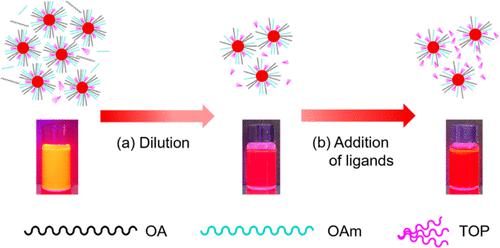当前位置:
X-MOL 学术
›
ACS Appl. Nano Mater.
›
论文详情
Our official English website, www.x-mol.net, welcomes your
feedback! (Note: you will need to create a separate account there.)
Trioctylphosphine- and Octanethiol-Induced Photoluminescence Recovery of CdSe/ZnS Quantum Dots after Dilution–Quenching: Implications for Quantum Dot Films
ACS Applied Nano Materials ( IF 5.3 ) Pub Date : 2023-02-09 , DOI: 10.1021/acsanm.3c00200 Hao Hao 1 , Hui-Ling Hu 1 , Yi Liu 1, 2 , Feng-Lei Jiang 1
ACS Applied Nano Materials ( IF 5.3 ) Pub Date : 2023-02-09 , DOI: 10.1021/acsanm.3c00200 Hao Hao 1 , Hui-Ling Hu 1 , Yi Liu 1, 2 , Feng-Lei Jiang 1
Affiliation

|
In this work, CdSe/ZnS core/shell quantum dots (QDs) were synthesized. Dilution of the as-synthesized QDs would lead to instability with photoluminescence (PL) quenching. It was found that the addition of tertiary phosphine and alkylthiol could recover the PL intensity of diluted QDs and make these QDs stable. Specifically, the recovery efficiency of tertiary phosphine was stronger than that of alkylthiol. Trioctylphosphine (TOP) and octanethiol (OT) were chosen as the representative ligands, respectively. Isothermal titration calorimetry (ITC) demonstrated that interactions between both TOP/OT and QDs were exothermic and spontaneous. The interaction between TOP and QDs was mainly driven by van der Waals forces due to the branched structure. This interaction had a negative entropy change, while the interaction between OT and QDs had a positive entropy change. There were about ∼12 TOP molecules and ∼17 OT molecules bound to a QD particle. The binding constants of TOP/OT to QDs were 1.6 × 103 and 12.8 × 103 M–1, respectively. The reaction rate between TOP and QDs was fast, and the addition of OT could slow the reaction rate constant from 0.081 to 0.024 min–1. PL decay indicated that TOP and OT could increase the radiative recombination of excitons. Furthermore, both TOP and OT could greatly improve the brightness of the QD films, which was a prerequisite for the efficient improvement of quantum dot light-emitting diodes. This work explicitly investigated the dilution process of QDs, explored the methods for keeping diluted QDs stable and bright, and highlighted the importance of surface ligands.
中文翻译:

稀释淬火后 CdSe/ZnS 量子点的三辛基膦和辛硫醇诱导的光致发光恢复:对量子点薄膜的影响
在这项工作中,合成了 CdSe/ZnS 核/壳量子点 (QD)。稀释合成后的 QD 会导致光致发光 (PL) 猝灭不稳定。发现添加叔膦和烷基硫醇可以恢复稀释 QD 的 PL 强度并使这些 QD 稳定。具体而言,叔膦的回收效率强于烷硫醇。分别选择三辛基膦 (TOP) 和辛硫醇 (OT) 作为代表性配体。等温滴定量热法 (ITC) 证明 TOP/OT 和 QD 之间的相互作用是放热的和自发的。由于分支结构,TOP 和 QD 之间的相互作用主要由范德华力驱动。这种相互作用具有负熵变,而 OT 和 QD 之间的相互作用具有正的熵变。大约有约 12 个 TOP 分子和约 17 个 OT 分子与 QD 粒子结合。TOP/OT 与 QD 的结合常数为 1.6 × 103和 12.8 × 10 3 M –1,分别。TOP和QD之间的反应速度很快,OT的加入可以使反应速度常数从0.081减慢到0.024 min –1。PL 衰变表明 TOP 和 OT 可以增加激子的辐射复合。此外,TOP和OT都可以大大提高QD薄膜的亮度,这是有效改进量子点发光二极管的先决条件。这项工作明确研究了量子点的稀释过程,探索了保持稀释后的量子点稳定和明亮的方法,并强调了表面配体的重要性。
更新日期:2023-02-09
中文翻译:

稀释淬火后 CdSe/ZnS 量子点的三辛基膦和辛硫醇诱导的光致发光恢复:对量子点薄膜的影响
在这项工作中,合成了 CdSe/ZnS 核/壳量子点 (QD)。稀释合成后的 QD 会导致光致发光 (PL) 猝灭不稳定。发现添加叔膦和烷基硫醇可以恢复稀释 QD 的 PL 强度并使这些 QD 稳定。具体而言,叔膦的回收效率强于烷硫醇。分别选择三辛基膦 (TOP) 和辛硫醇 (OT) 作为代表性配体。等温滴定量热法 (ITC) 证明 TOP/OT 和 QD 之间的相互作用是放热的和自发的。由于分支结构,TOP 和 QD 之间的相互作用主要由范德华力驱动。这种相互作用具有负熵变,而 OT 和 QD 之间的相互作用具有正的熵变。大约有约 12 个 TOP 分子和约 17 个 OT 分子与 QD 粒子结合。TOP/OT 与 QD 的结合常数为 1.6 × 103和 12.8 × 10 3 M –1,分别。TOP和QD之间的反应速度很快,OT的加入可以使反应速度常数从0.081减慢到0.024 min –1。PL 衰变表明 TOP 和 OT 可以增加激子的辐射复合。此外,TOP和OT都可以大大提高QD薄膜的亮度,这是有效改进量子点发光二极管的先决条件。这项工作明确研究了量子点的稀释过程,探索了保持稀释后的量子点稳定和明亮的方法,并强调了表面配体的重要性。


















































 京公网安备 11010802027423号
京公网安备 11010802027423号